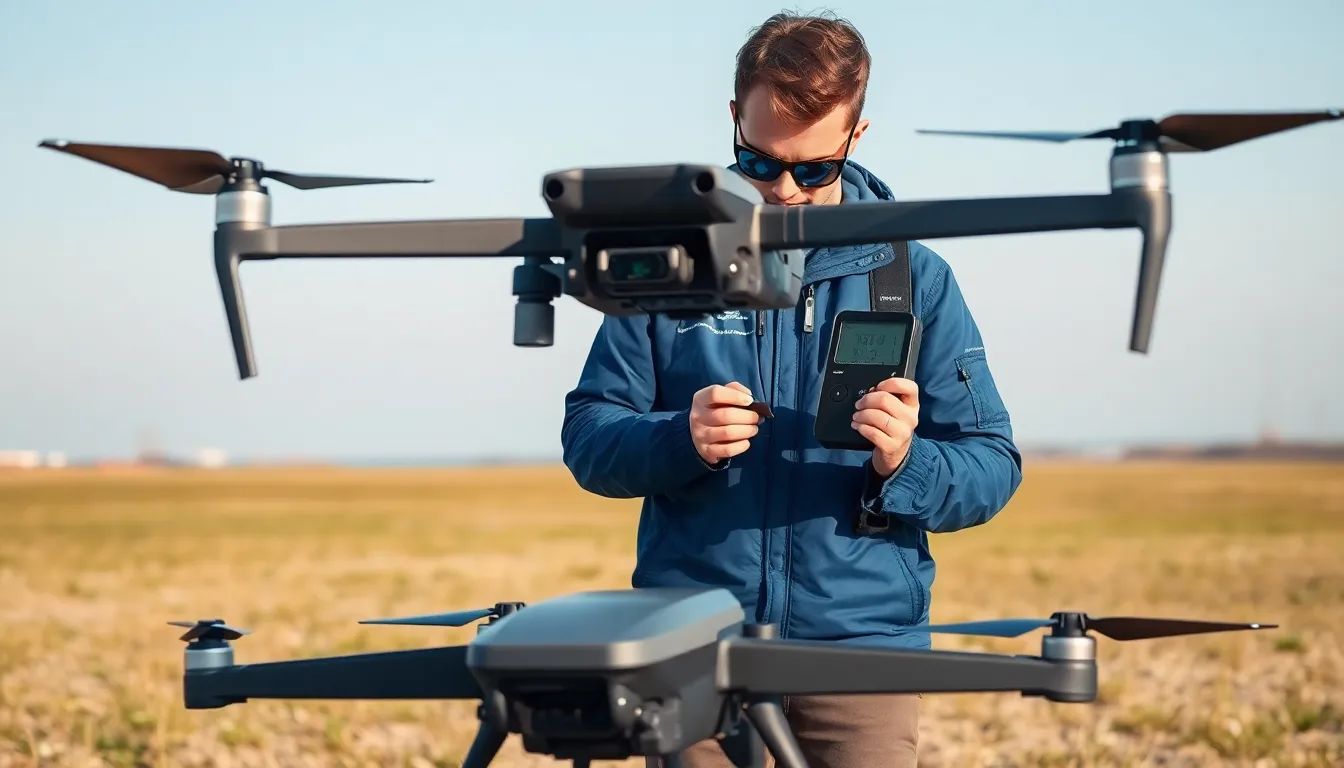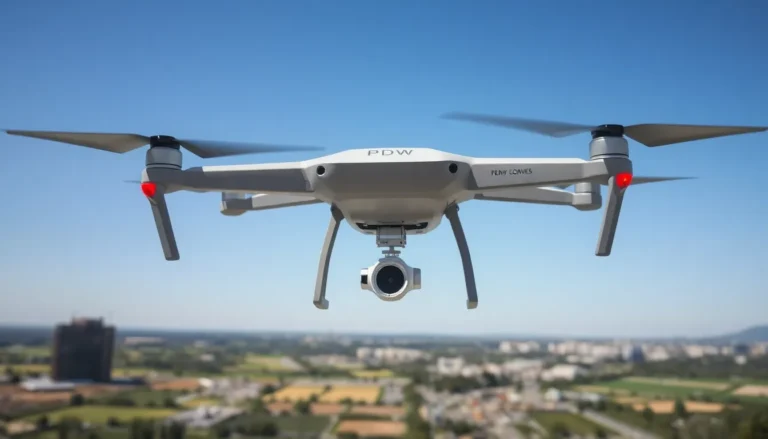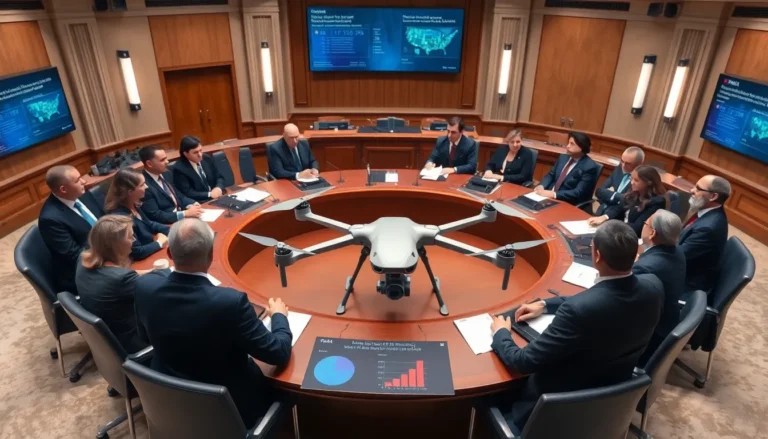In the high-flying world of drones, battery life is the ultimate party crasher. Just when you’re about to capture that breathtaking sunset or impress your friends with a daring aerial stunt, your drone decides it’s time for a nap. It’s like planning a road trip and realizing you forgot to fill up on gas—definitely not the thrill you signed up for.
Understanding drone battery life isn’t just for tech enthusiasts; it’s crucial for anyone looking to make the most of their aerial adventures. From the type of battery to flight conditions, several factors play a role in how long your drone can soar. So buckle up and get ready to dive into the electrifying world of drone batteries, where knowledge is the key to keeping your drone in the sky and your creativity flowing.
Table of Contents
ToggleUnderstanding Drone Battery Life
Drone battery life can significantly influence flight plans and creative opportunities in aerial photography. Recognizing the variables that impact battery performance proves essential for drone enthusiasts.
Factors Affecting Battery Life
Temperature plays a crucial role in battery efficiency. Cold weather often diminishes battery capacity, reducing flight time. Altitude impacts performance; flying at higher elevations can drain batteries faster. Flight speed also affects longevity; faster speeds consume more energy. Payload weight matters; additional equipment leads to shorter battery life. Finally, flight patterns can influence energy usage; hovering uses less battery than constant movement.
Types of Drone Batteries
Lithium Polymer (LiPo) batteries dominate the drone market due to their high energy density and lightweight structure. They offer quick discharge rates, ideal for demanding flights. Nickel-Metal Hydride (NiMH) batteries provide more stability but usually weigh more and have lower energy densities. Lithium-Ion (Li-ion) batteries are popular for longer-lasting flights but may have lower discharge rates compared to LiPo. Selecting the right battery type is vital for maximizing drone efficiency and enhancing flight experiences.
Measuring Drone Battery Life

Understanding how to measure drone battery life is essential for maximizing flight efficiency. Several factors influence performance, including battery type and environmental conditions.
Flight Time vs. Battery Capacity
Flight time relates closely to battery capacity, expressed in milliamp-hours (mAh). Higher mAh ratings typically indicate longer flight times. Battery capacity, however, doesn’t solely dictate performance. Factors such as drone weight and speed also play a significant role. For example, a heavier payload requires more energy, reducing flight time. Operating in cold weather can diminish battery efficiency, leading to shorter durations. Knowing how to balance these elements helps pilots achieve optimal flight experiences.
Real-World Testing
Real-world testing provides valuable insights into actual battery performance. Conducting test flights under varied conditions allows operators to gauge flight time accurately. Variables like wind resistance and temperature can significantly impact outcomes. Many pilots recommend testing with different payloads to determine how each affects battery life. Keeping records of various flights helps in understanding performance trends. Consistently collecting this data leads to informed decisions regarding battery usage and replacement.
Tips to Extend Drone Battery Life
Extending drone battery life involves careful planning and attention to detail. Implementing best practices in charging and maintenance can lead to more enjoyable flight experiences.
Proper Charging Techniques
Charging drones correctly plays a vital role in maintaining battery health. Use the manufacturer’s recommended charger to ensure compatibility and efficiency. Avoid overcharging; stopping the charge when the battery reaches full capacity prevents damage. Additionally, charge batteries in a cool, dry environment to avoid overheating. Only use batteries that feature built-in protection circuits, as these help regulate charging and discharging, enhancing safety. Performing a calibration cycle every few months can also contribute to more accurate energy readings and optimal performance.
Maintenance Practices
Regular maintenance dramatically improves drone battery longevity. Start by inspecting battery terminals for corrosion or dirt, as clean connections ensure better energy transfer. Storing batteries away from extreme temperatures preserves their lifespan; a cool environment is ideal for long-term storage. Discharge lithium batteries, if not used for extended periods, to around 30-40% capacity before storing. Regularly checking battery performance helps identify potential issues before they become significant problems. Embracing these proactive measures can significantly enhance the reliability and efficiency of drone batteries.
Future of Drone Battery Technology
Drone battery technology is evolving rapidly, focusing on enhancing performance and sustainability. Innovations aim to improve flight times, reduce charging durations, and create environmentally friendly options.
Innovations on the Horizon
Many companies are exploring solid-state batteries, which could significantly increase energy density and safety. Solid-state technology promises higher capacities for longer flight times. Research into lithium-sulfur batteries indicates potential for cheaper materials combined with longer life cycles. Additionally, advancements in battery management systems enable smarter energy usage, maximizing efficiency during each flight. Such developments contribute to greater reliability and flexibility for drone applications.
Environmental Considerations
Sustainability is a key focus in future drone battery innovations. Biodegradable batteries are in development, aiming to minimize environmental impact while maintaining performance. Reduced reliance on non-renewable materials enhances the ecological footprint of drones. Companies are also investigating recycling techniques to extend battery life and reduce waste. Efforts to create energy-efficient charging stations align with broader environmental goals, promoting cleaner operations. Such considerations highlight the industry’s commitment to sustainability while pushing technological boundaries.
Understanding drone battery life is essential for any pilot looking to optimize their flying experience. By recognizing the various factors that influence battery performance and applying effective maintenance practices, operators can significantly enhance their drone’s reliability. As battery technology continues to evolve, embracing new innovations will further improve flight times and sustainability. With the right knowledge and proactive measures, drone enthusiasts can ensure their devices remain airborne longer, capturing breathtaking aerial moments without interruption.








